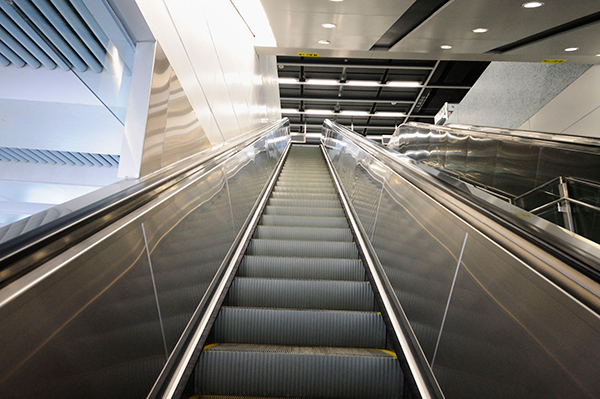
1. Cascade failure
The stairway is a standing place for passengers to take a ladder and a continuous running part. Due to environmental conditions, human factors, such as the object itself causes, cascade failure mainly has the following aspects: tooth broken, pedal stent fracture spindle hole, stent fracture, the main wheel come unglued.
2. Failure of the drag chain.
Drag chain is one of the largest stress escalator parts, due to the long running, accordingly more serious wear and tear, and the main fault include lubrication system fault, drag chain serious wear and tear, drag chain elongation.
3. Failure of the driving device.
The main fault of the driving device includes the abnormal sound of the driving device, the temperature rise of the driving device is too fast and too high. The reasons for failure of the driving device are as follows:
(1) motor, worm, worm gear bearing, reducer bearing wear and damage of band brake brake motor, brake adjustment doesn’t fit, spacing of the coil and the friction plate drive chain is too loose, severe vibration or jump up and down.
(2) The motor bearing is damaged, the motor is damaged, the oil quantity of the reducer is insufficient, the oil product is wrong, the friction pair clearance adjustment of the brake is not suitable, the friction pair is burnt out, and the internal short circuit of the coil is burnt out.
4. Ladder road fault
The main faults include: stair running off, the step at run time touching the skirt board. The reasons are various, and the description is as follows:
(1) The ladder is not running horizontally on the ladder, and the branches are not horizontal.
(2) The installation of main auxiliary rail, anti-rail, main auxiliary rail bracket and so on.
(3) The clearance between the two adjacent steps should be kept constant during the operation of the cascade.
(4) The two guides are not parallel in horizontal direction.
5. Tooth comb front plate failure.
When the escalator is running, the steps of the ladder will come out from the comb teeth, and it will carry 8,000 to 9,000 passengers per hour. The working conditions of the comb teeth are obvious. Therefore, the comb rod is liable to damage; The surface of the front plate is easy to get stuck with the foreign body of the passenger’s sole; The teeth of the comb teeth are not meshed with the notch of the notch, and when there is a foreign body, it is prone to deformation and fracture.
6. Handrail fault
The fault of the handrail device often occurs in the handrail driving part. Due to the limitation of position, the structure design of the armrest drive part is difficult, which is easy to be damaged by bearing, chain and driving belt. During routine inspection, the user should adjust the degree of tension of the driving chain properly: the pressure spring of the linear pressure belt should not be too tight, and the pressure spring of the arc pressure belt should not be too tight; Grease should be added to each bearing.
The handrail is long running and can be elongated, which can be adjusted by the regulating mechanism installed at the lower end of the escalator. Hand strap at run time, the arc end rustling, sometimes this is because the circular arc of the handrail bracket has a set of bearing, the damage caused by abnormal sound is often bearing, bearing should be timely replacement.
7. Safety device failure.
1) Fault type of safety protection device.
(1) Excessive elongation or failure of the traction chain.
(2) Failure of the comb tooth foreign body protection device.
(3) The handrail enters the mouth safety protection device failure.
(4) Failure of the step sinking protection device.
(5) Fault of drive chain broken chain protection device.
(6) Fault of the armrest belt fault protection device.
2) Failure analysis of escalator safety protection device.
(1) When the drag chain is too elongated or broken, the drag chain moves backward, and the power is shut down after the action of the trip switch.
(2) Comb plate foreign body protection USES a set of mechanism to make the pull rod move backward, so that the trip switch action can be shut down.
(3) The handrail enters the mouth safety protection device to use the leverage to enlarge the stroke and touch the travel switch, thus causing the power failure.
(4) Failure of the descending protective device of the step, and the detection rod is encountered in the sinking part, which causes the stop of the test bar action to trigger the trip switch action.
(5) The driving chain protection device is broken through double row roller belt, make the power through the reducer to drive the spindle (when hoisting height more than 6 m by the regulation, should configure the device). Drive chain fracture, can make trip switch power off.
(6) When the handrail is not tested with more than 25 kN tensile test, it is necessary to set the armrest band break belt protection device. The handrail is rotated by the driving wheel, and once the handrail is broken, the roll on the switch of the arm with the pressing of the handrail is swung and the power failure stops.
